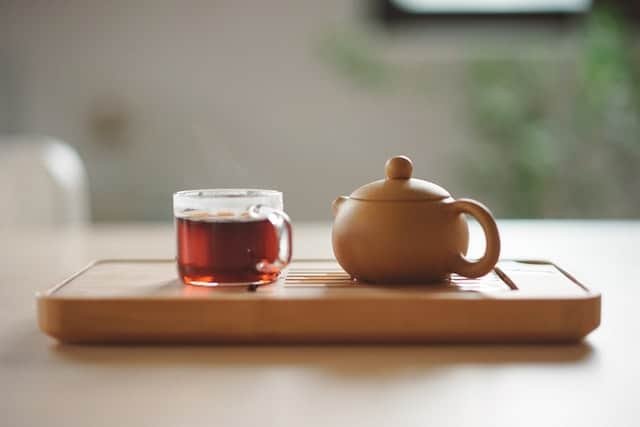
Red tea is the name we usually give in the West to pu-erh, a tea from China, with a great history, great health benefits and a peculiar but pleasant earthy taste. Red tea is highly valued in Traditional Chinese Medicine for its medicinal properties as a purifier.
What is the pu erh, common confusions
Pu-erh is obtained from the same plant as green or black tea, Camellia sinensis, the tea plant; but it has a secret to which it owes its taste peculiarities and many of its health benefits: fermentation. In the same way that occurs with wines and denominations of origin, the cultivation of red tea cultivation is restricted to specific areas and its production is governed by strict regulations.
Red tea lends itself to some confusion. If you order one in Spain, you’ll most often get a cup of pu-erh, but if you do the same in England, you might end up drinking (or throwing back) a cup of rooibos or even hibiscus tea (Hibiscus sabdariffa). In fact, if you do the same in China (or rather if your guide does it for you), you will be served black tea. What we know as black tea in the West is called 紅茶, literally red tea, in Chinese, Korean, Japanese and a long list of other Asian languages. What a mess, and all because of the color… red.
It’s taste
The flavor of red tea varies strongly depending on its degree of fermentation. Its range of flavors reaches a pleasant bitterness and astringency in young teas and evolves to smoother and more complex flavors in aged teas. While younger teas provide floral and camphor notes, older teas tend toward flavors that are described as musty or earthy and thicker mouthfeels.
If you find acidic flavors or flavors that remind you of fish, know that these are indicators of poor quality teas.
Why is it red?
Red tea owes the color of its infusion to a process of oxidation and subsequent microbial fermentation through the action of molds, bacteria and yeasts that can last from a few years to decades. During it, the leaves acquire a brownish color that transforms into a splendid red when infused.
The pu-erh tea manufacturing process is divided into three fundamental steps.
- Collection of selected leaves of the tea plant.
- Obtain maocha, or dried tea leaves, by drying to stop oxidation.
- Ferment the maocha to obtain the final product. It should be noted that this step is optional, its completion or lack of it gives rise to various types of pu-erh tea.
Different varieties: raw and matured pu-erh
The process of obtaining pu’er gives rise to varieties of it with a very different taste and health properties.
After the tea leaves are harvested, they are roasted in a large wok in a process called “killing the green” which stops enzyme activity in the leaf and prevents complete oxidation. After roasting, the leaves are rolled, rubbed and shredded to gently bruise and then left to dry in the sun.
Once dried, the maocha can be consumed or sent to the factory to be pressed into crackers or bricks of raw pu-erh. Which may or may not be stored in the right conditions to get an aged raw pu-erh.
An alternative path for maocha is to go through the fermentation phase to get a matured pu’er.
As with wine, not all kinds and qualities of pu-erh are suitable for a fermentation or aging process. There are inescapable requirements for a tea to improve with time or with fermentation.
Raw Pu-erh (Puerh Sheng): unfermented red tea. More powerful, fresh and bitter flavor. Raw pu’erh can be consumed directly or compressed into the famous tea bricks to be aged (not fermented).
Matured Pu-erh (Puerh Shu): Red tea fermented through the complex and secretive Wodui (stacked fermentation) process. The color of the tea leaves varies to a darker red. Mild, earthy flavor and denser texture. The matured pu-erh achieves sophisticated nuances of flavor that make it highly appreciated. The cost of tea is usually linked to the years of fermentation, with exorbitant figures being paid for the oldest leaves.
Red tea producing regions
Red tea production is highly centralized in China’s Yunnan province. The main producing areas are the Six Great Tea Mountains, known for climatic conditions that offer excellent conditions for the cultivation and growth of tea. Similar to the wine world with terroir, it is considered that the terrain of each of the mountains imprints a special character on the taste of tea. There are other producing areas in the region.
Pu-erh a “product with geographical indications”, which would be a kind of denomination of origin that restricts the use of the term pu-erh for teas produced exclusively in specific regions of the province. from Yunnan.
Although Yunnan produces most of the pu-erh worldwide, there are other producing areas in China itself, such as Hunan or Guangdong, and also in neighboring countries such as Vietnam, Laos or Burma.
History and origins
There are historical records of the existence of red tea documented since the times of the Tang Dynasty (618 – 907 AD). At that time, tea began to be compressed in the form of a brick to facilitate its transport.
Already in those times, tea was marketed through endless routes that traveled through China and crossed its borders. The distances were enormous, and even more so in those times when the means of animal transport and the arduous roads made tea take months. and months to reach its destination.
This time that the tea spent traveling and subjected to inclement weather caused it to spontaneously begin to ferment. The merchants realized that the same tea, drunk at its origin and at its destination, had changed drastically and not necessarily for the worse.
The nobility became interested in this delicious new tea and pu’er gained popularity.
Red tea qualities
A long history and great acceptance have created a complex world around the tasting and evaluation of red tea. Pu’er is usually classified into 10 different qualities. If you want to try the experience of an authentic Pu Erh at an adequate price, our Supreme Pu Erh is an excellent option.
In summary, there are several fundamental factors to judge the quality of red tea.
Origin of tea bushes
Or rather, from the plants from which the leaves are extracted. The plants can be cultivated in plantations, feral due to the abandonment of the fields or wild. Plants grown in the wild without human intervention and with a high age are the most valued, as they are considered to provide deeper and more complex flavors, often with notes of mint or camphor.
Pickup Season
The harvest season plays an important role in the taste of the tea. The most valued is spring tea, followed by autumn and, finally, summer. Pu-erh is rarely collected in winter.
Time and quality of the fermentation process
Long fermentation times define, in part, a higher quality of tea. However, it is important to note that not all types of pu-erh will accept a fermentation process well. On the other hand, there is a suitable fermentation time for each batch, if it is exceeded, the quality of the tea will decline.
It goes without saying that the fermentation process can be affected by conditions outside the tea. Changes in the temperature or humidity of the environment can negatively affect the fermentation process and leave unpleasant tastes, such as that of dried fish.
Uses in Traditional Chinese Medicine
Traditional Chinese Medicine is a medical system based on the belief in the existence of a vital flow called chi that circulates throughout the body through pathways called meridians. Failures in the circulation of this vital energy are the cause of diseases.
Traditional Chinese Medicine uses resources such as acupuncture, massage and herbal remedies to solve conditions.
The use of red tea in Traditional Chinese Medicine comes from ancient times. According to this, the consumption of red tea would serve to eliminate a concept called internal humidity, which would describe problems of the spleen to transform the energy it receives from the intestines.
In this way, the red tea would serve to help the spleen to work well and would act as a purifier of the body.
The properties of red tea
Leaving aside its role in the role it has played for generations in Traditional Chinese Medicine, there are scientific studies that support the benefits of red tea for the following situations. Investigation continues and it is considered that there is still no conclusive evidence on this subject to date.
To lose weight
The pu-erh provides a series of benefits related to the digestion and absorption of fats that can help you lose weight. Red tea aids in digestion and helps improve constipation thanks to the lovastatin naturally present in tea leaves. The antioxidants and polyphenols also help in the digestion and breakdown of fats.
A recent study showed that pu’er tea suppresses fat production in rats.
Traditional Chinese medicine considers pu-erh as a method to prevent “internal dampness”. This term is used to describe the spleen’s inability to transform energy from the intestines. This tea has traditionally been used to activate the spleen and help it function properly. It is also known for its ability to detoxify the entire body and remove toxins from the system.
Pu-erh tea promotes the production of epinephrine and norepinephrine, which deplete fatty acid stores.
It is advisable to have a cup of pu-erh a while after eating to help the body reduce excess fat. If taken before a meal, its purifying effects can increase appetite and therefore achieve the opposite effect to that desired.
Reduce “bad cholesterol”
A Chinese study of obesity-induced rats suggests that red tea may lower LDL cholesterol and prevent obesity-related diseases. In fact, there is a specific mix of pu-erh tea in Shanghai used in traditional Chinese medicine to lower cholesterol.
Protect the heart
Traditional medicine has long valued the benefits of pu-erh for health. Current studies suggest that the consumption of red tea may serve to reduce the incidence of cardiovascular disorders thanks to lipid-lowering compounds and antioxidants naturally present in it.
Strengthen the immune system
Since pu’erh undergoes an oxidation process during its production, its antioxidant content is comparatively lower than that of green or white tea. However, it is still a supplement to tone up your immune system thanks to its content of vitamin C and antioxidants.
Prevent the formation of tumors and cancer cells
There are already several studies, for the moment on animals, that show a relationship between the regular consumption of red tea and the brake on the growth of cancer cells. The beneficial effects of red tea components to target specific tumor cells without negative side effects. A second study demonstrated its effects in inhibiting the proliferation of cancer cells.
Studies attribute this effect to the polyphenols present in the tea thanks to the oxidation process, which help to eliminate free radicals and stop the production of irregular cells. It is important to continue this line of research to confirm these beneficial effects.
Treat osteoporosis
Some early results have already been obtained indicating beneficial effects of red tea on bone health. This study suggests a relationship between consumption of red tea extract and an amelioration of the effects of osteoporosis in rats.
How red tea is prepared

Step 1: Don’t overdo the tea
Add a teaspoon of red tea for every cup of water you put in the kettle.
Step 2 – Boil Water
The recommended temperatures to infuse the pu-erh vary between 95º C for the most basic quality teas and between 85 – 89º C for the most select ones.
Step 3 – Don’t Infuse It Too Much
Let the infusion rest for 2 minutes.
Step 4: Do it your way
Red tea accepts sweeteners well or a little lemon. To reduce the astringency, you can add a cloud of milk.
